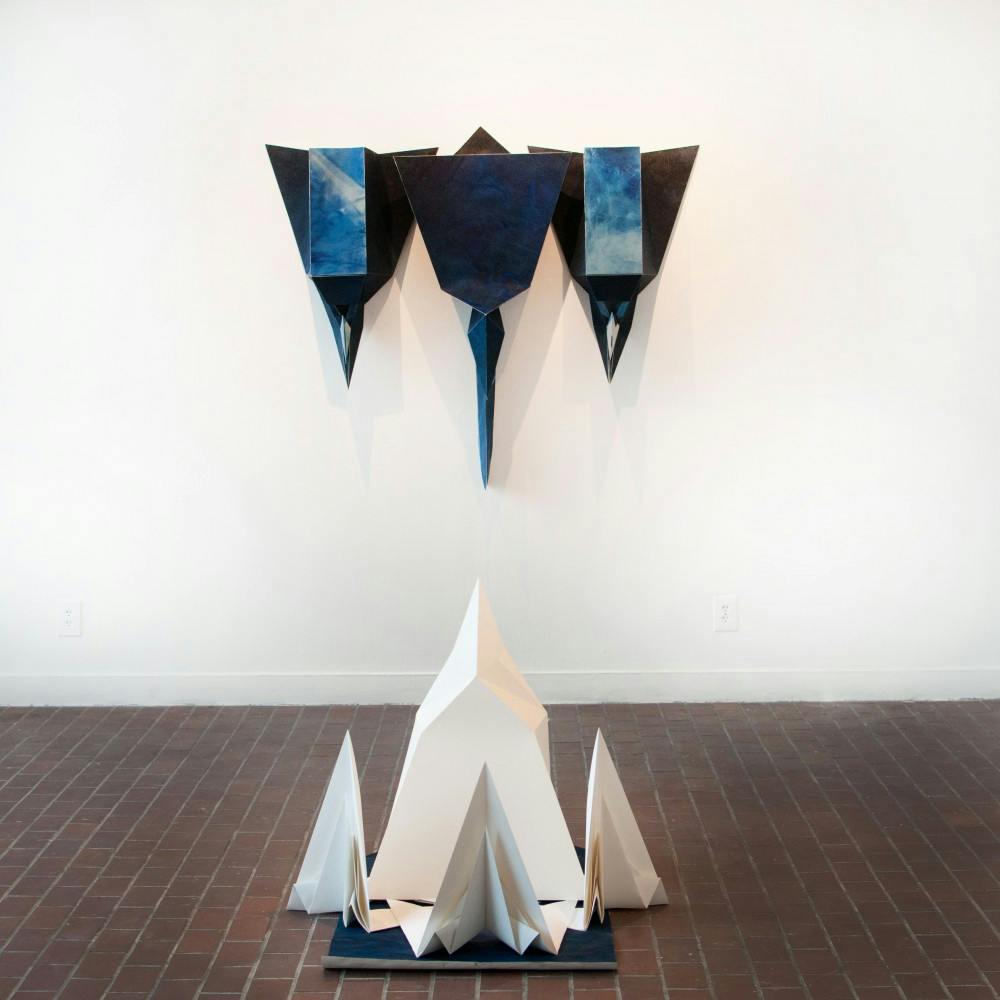Master of Fine Arts student Isabel Cuenca, who was born in the Philippines, was exposed to two very different environments growing up in the U.S. As a result, she developed an interest in spaces and the artist’s ability to create various emotions within any space.
Her exhibit at the John and June Allcott Gallery in the Hanes Art Center, which is a part of the nine-week long MFA exhibition series, creates an opportunity for viewers to step out of their busy lives and into a celestial space where silence and internal contemplation is encouraged.
Staff Writer Ally Levine spoke with Cuenca about her discovery of the aesthetic opportunities for creating emotion within a space.
Daily Tar Heel: What is your current artistic focus?
Isabel Cuenca: I’ve always been interested in the formal qualities of line and abstraction to depict space. When I was painting, I was painting geometric abstraction in order to depict space, in order to depict these barren landscapes through geometry. And, from that, I got into this photo process called cyanotype. It does something I couldn’t do with my paintings. It allowed me to be free in terms of the rigidity of lines. It allowed me to let chance happen with the work. Also, it allowed me to really shape the space. For example, with the exhibit, it allowed me to shape the gallery space and make it quiet and cold. The way I approach art making is very formal. I’m really interested in aesthetics, line, and all that stuff.
DTH: What should people expect to see in your exhibit this week?
IC: It’s going to be a cold, quiet exhibit. It’s very minimal. Every piece has its own space. There’s enough space in between pieces to sort of contemplate them separately or step back and take it all in. It’s quiet, it’s minimal, and it sort of sets a quiet stage.
DTH: Why is it entitled “Where Lost Boys Gather”?
IC: It was something that I wrote for this gallery talk before I got into the Allcott Gallery. I was really questioning: What was this space that I was depicting? What is it to me? When I look at spaces, I think of a narrative that goes with it. What becomes of the space when you put your work in it? It becomes this other dimension. You cross that glass wall and it’s quiet compared to the busy hallways when classes end and people are in and out constantly. So, the entrance to the gallery becomes a space of its own; it becomes a different dimension.
I was thinking about what narrative gave me that separation between the real world and something fictional. I thought of Peter Pan because the work is very celestial — there’s blue and there are lines that sort of reference constellations where lines meet and the paper frazzles. It becomes constellations like the ones that are in written format or drawn format. The idea of the star becoming this transportation device is of the lost world where Peter Pan takes Wendy. And so, that is where I’m leading this alternative space – to this other dimension that you can create within the gallery space and within your work.
DTH: Do you see your Filipino background as transcending into your art?
IC: Of course, to be interested in space is telling. The Philippine environment and the environment here are totally different. I take both of those and apply them to something abstract. Also, the idea of storytelling is what I grew up with. I grew up having governesses and people other than my parents near us as children. They’d tell us stories. Even in school, the stories that we read in English class are different from the stories that we read here in the U.S. All of those things, they’re definitely there in my work. Even color choices, things that I’ve experienced, wearing traditional Filipino clothes are considered in my art making. So yes, a lot of what I do, even if it’s abstract, it’s definitely part of my identity.
DTH: What do you hope people will take away from the exhibit?
IC: I think I want them to take away this moment that they can be contemplative. To go in there is to slow down and be immersed by something else, something not quite real, something a little more fictional. By doing that you’re allowing yourself this playfulness of the imagination or even just looking at the piece and enjoying where lines blend and play with each other. Just a moment of quiet. Just a moment to slowdown and to be taken away.
DTH: What do you plan to do with your MFA?
IC: I think short-term I would love to keep working, keep experimenting, keep pushing myself in the things that I’m interested in. That includes residencies and fellowships. The long-term goal for me, because I was born in the Philippines and when I was growing up I never really had any experiences in the arts except for arts and crafts with my mother, is that I’d love to bring this education that I got here in the States to learn about art and immerse myself in art, back to the Philippines.
arts@dailytarheel.com
To get the day's news and headlines in your inbox each morning, sign up for our email newsletters.




